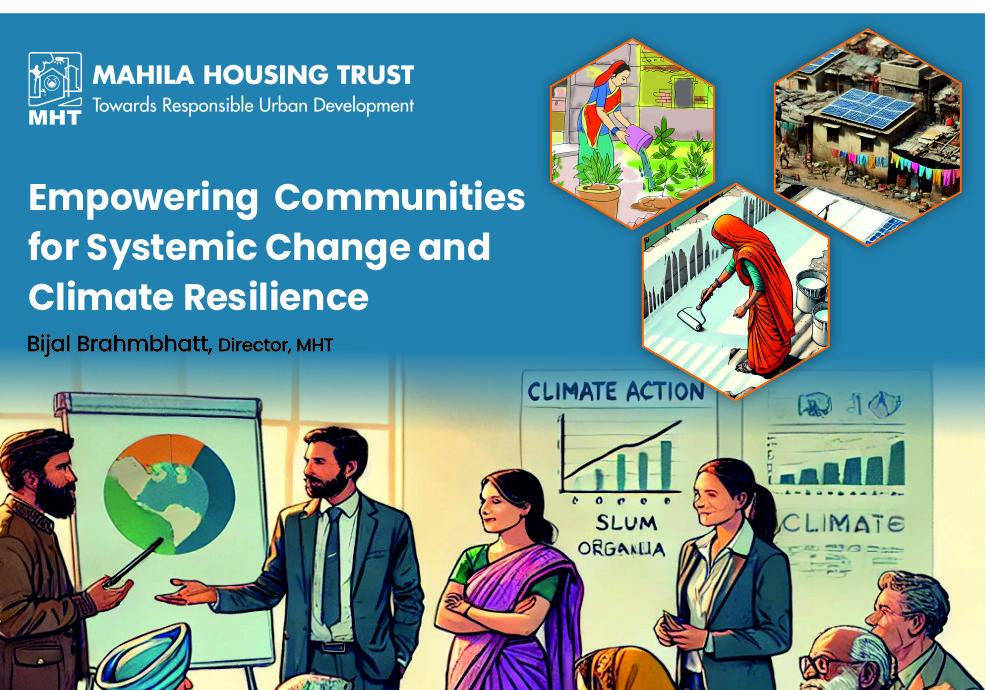
Empowering Communities for Systemic Change and Climate Resilience
In the face of escalating climate challenges, the importance of community engagement in building resilience cannot be overstated. At Mahila Housing Trust (MHT), our experience has shown that empowering communities simultaneously also catalysing the other stakeholder eco-system leads to systemic, long-term change.
Engaging Communities Through Innovation
Traditional approaches to climate resilience often fail to connect meaningfully with the people most affected, Communities need to be empowered with the right tools, and knowledge. At MHT, we have embraced gamification, videos, and storytelling as key tools to bridge this gap. These methods demystify complex concepts like climate change and risk mitigation, making them accessible and actionable for women-led community groups.
This deep engagement has enabled communities to actively participate in developing climate action plans, heat action plans, and other localized interventions. These are not just plans on paper but actionable blueprints rooted in the realities and priorities of the people who will implement them.
Redefining Infrastructure: Beyond Brick and Mortar
One of the critical points we emphasized at recent discussions with the Coalition for Disaster Resilient Infrastructure (CDRI) is the need to expand the definition of infrastructure. It must include nature-based solutions—an essential element for sustainable and climate-resilient infrastructure development. By integrating natural systems into infrastructure planning, we can create solutions that are not only resilient but also environmentally sustainable.
I also commend CDRI for championing the concept of community resilience through infrastructure development. This shift acknowledges that infrastructure should empower communities, creating a foundation for them to lead their own transformative change.
Key Takeaways for Equity and Resilience
Our work at MHT offers valuable lessons for achieving social equity and climate resilience:
🏠 Defining Equity: Equity is not just about equal access—it’s about recognizing systemic barriers and ensuring tailored support for vulnerable groups to overcome them.
🌱 Balancing Sustainability: Environmental sustainability must be integrated into recovery efforts without compromising social equity. Both goals are essential and interconnected.
📚 Lessons from Disasters: Case studies consistently highlight the critical role of community-driven approaches in ensuring equitable and resilient recovery.
Building Resilience Through Community Leadership, and catalysing the ecosystem.
At MHT, we’ve witnessed how empowering women to take the lead can transform entire communities. By equipping them with the skills and confidence to understand and act on climate risks, we foster leadership that drives sustainable housing, social equity, and resilience. Most importantly, the leadership developed should also be able to catalyse the eco system, society, governments, and markets.
This approach turns vulnerability into strength. It shows us that the most effective solutions are those shaped and implemented by the very communities they aim to serve.
Looking Forward
The path to a resilient future is clear: we must continue to prioritize community leadership, integrate sustainability into every step, and redefine traditional models of infrastructure and recovery. Together, we can build a world where every home—and every community—is resilient, sustainable, and fair.
Let’s commit to this vision and ensure that no one is left behind.
What do you think? Let’s continue the conversation on how we can empower communities to catalyse the eco-system for a sustainable and equitable future.
Bijal Brahmbhatt, Director, MHT
